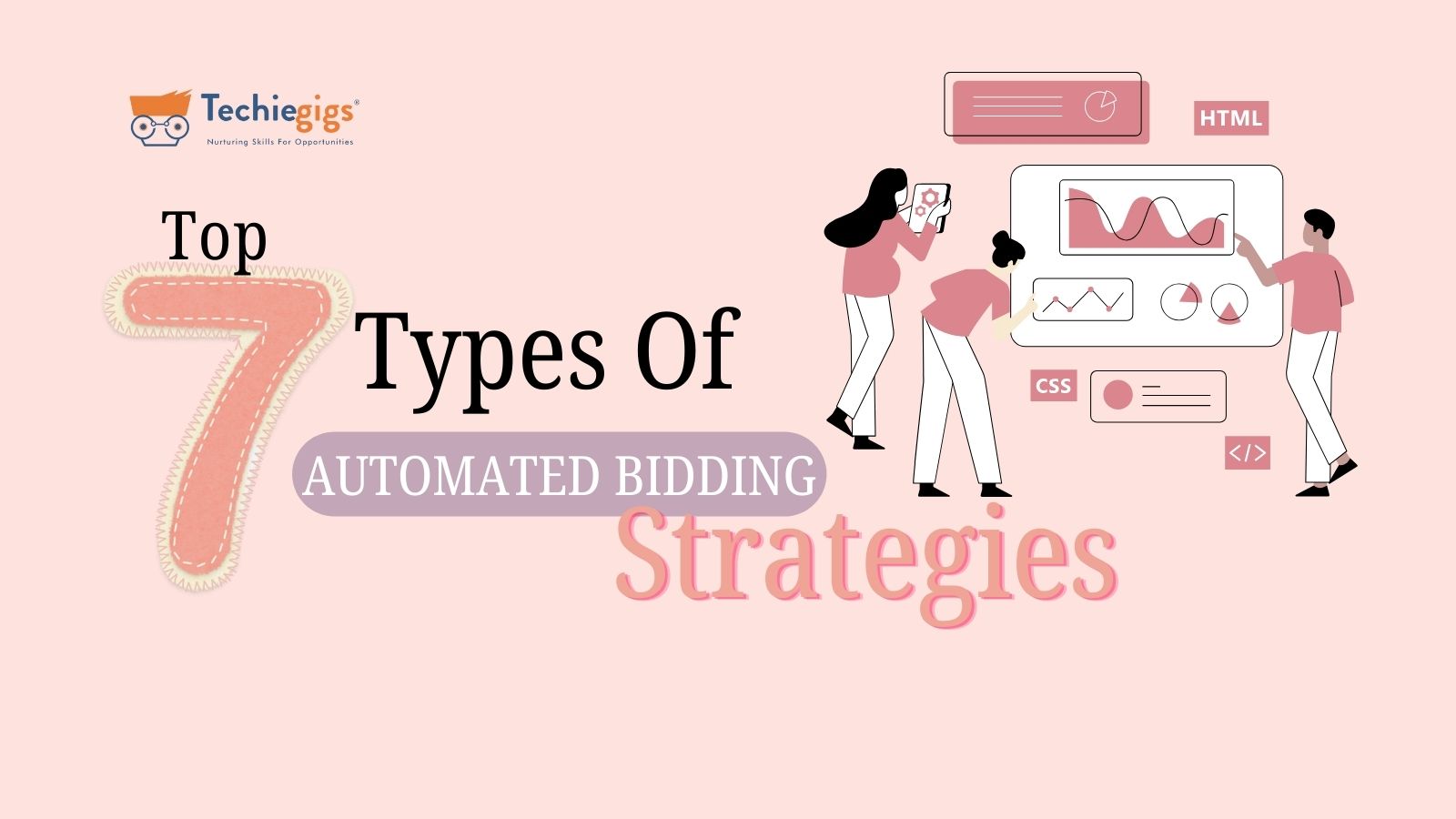The way automated bidding work is by putting a certain amount on an specific Ad campaign to gain the attention of the audience to gain more reach for the brand. Automated bidding is one of the most significant breakthroughs in recent years. Automated Bidding in Google Ads has emerged as a crucial tool for firms looking to boost efficiency and ROI. This article delves into the principles, benefits, limitations, and best practices for implementing Automated Bidding efficiently. Before you learn about Automated Bidding lets learn about Google Ads.
What is Google Ads ?
Google Ads is an online advertising platform developed by Google, allowing businesses to create and display ads on Google’s search engine, YouTube, and its network of partner websites. It operates on a pay-per-click (PPC) model, meaning advertisers pay when users click on their ads.
What is Automated Bidding?
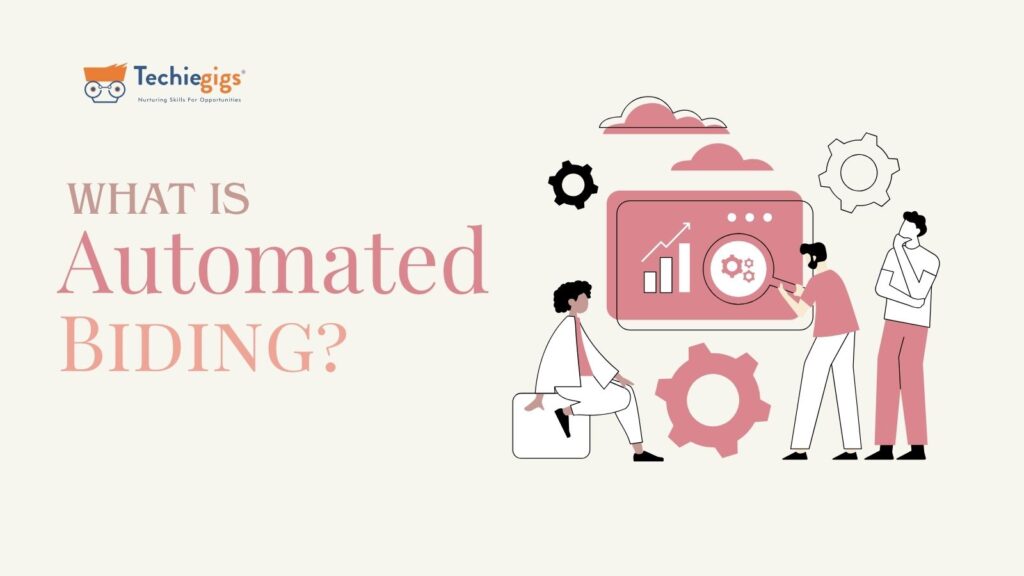
Automated Bidding is a strategy in Google Ads used to adjust bids automatically based on real-time data. Unlike manual bidding, where advertisers set bid amounts manually, Automated Bidding optimizes bids to achieve the best results within a set budget. This strategy enables advertisers to focus on broader campaign objectives rather than adjusting bids frequently. By using Automated Bidding, businesses can ensure that their ads remain competitive without constant manual intervention.
Overview of Google Ads Automated Bidding Strategies
Each Automated Bidding strategy serves a specific purpose and is designed to meet different campaign goals. Below are the most commonly used Automated Bidding strategies:
1. Maximize Clicks
- Focuses on driving maximum traffic to a website within a given budget.
- Best suited for campaigns prioritizing website visits.
- Uses historical data to predict the best bid values for increased clicks.
- Ideal for businesses looking to expand brand awareness.
2. Target Search Page Location
- Ensures ads appear at the top of Google’s search results.
- Ideal for brand awareness and visibility.
- Helps advertisers compete for the most prominent ad placements.
- Works well for campaigns with a strong emphasis on visibility rather than direct conversions.
3. Target CPA (Cost Per Acquisition)
- Aims to acquire conversions at a predefined cost.
- Best for businesses with strict budget constraints.
- Uses historical conversion data to optimize bids efficiently.
- Ensures advertisers maintain profitability while scaling conversions.
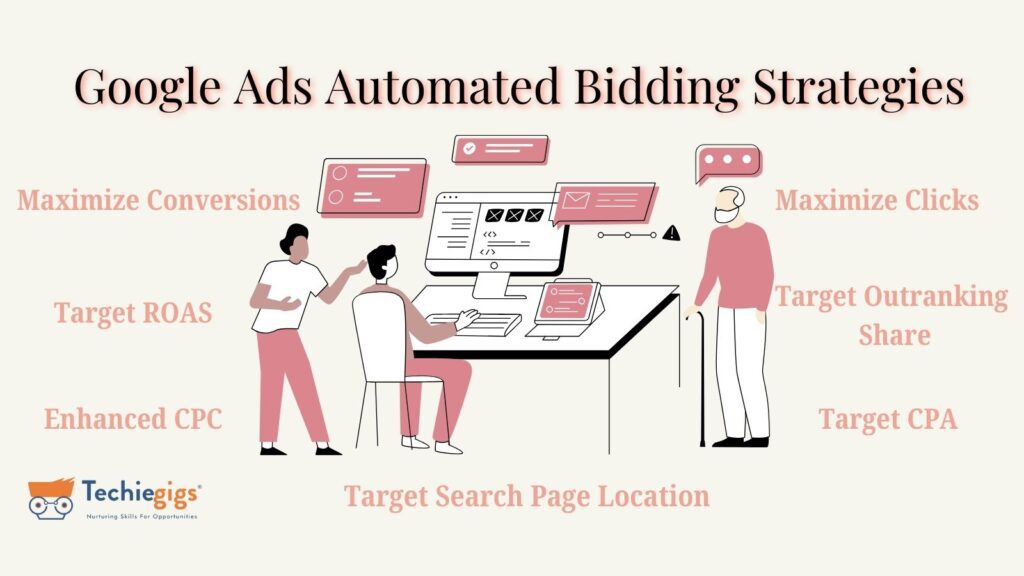
4. Target ROAS (Return on Ad Spend)
- Optimizes bids to achieve a specific revenue-to-spend ratio.
- Ideal for eCommerce and revenue-driven campaigns.
- Helps businesses focus on generating the highest return on investment.
- Requires strong historical conversion value data for accurate predictions.
5. Maximize Conversions
- Focuses on generating as many conversions as possible within the budget.
- Suitable for campaigns prioritizing lead generation or sales.
- Uses smart bidding to optimize bids in real time.
- Works best for businesses looking to scale customer acquisition without CPA constraints.
6. Enhanced CPC (Cost Per Click)
- Adjusts manual bids to increase conversions while maintaining control over keyword bids.
- Balances automation with manual bid management.
- Helps advertisers improve conversion rates while still having some bid control.
- Ideal for advertisers transitioning from manual bidding to full automation.
7. Target Outranking Share
- Ensures ads outrank competitors’ ads in search results.
- Best for brands looking to dominate specific keywords.
- Helps businesses maintain a competitive edge in high-stakes markets.
- Works well when competing directly with specific competitors for market share.
Advantages of Using Automated Bidding
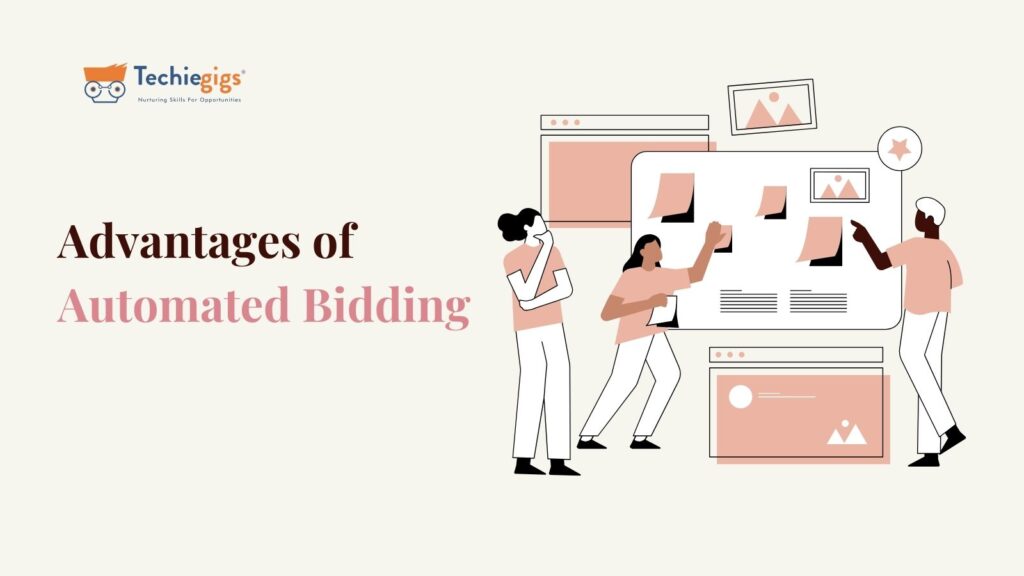
1. Efficiency and Time Savings
Automated Bidding eliminates the need for manual bid adjustments, allowing advertisers to focus on strategy rather than bid management. It significantly reduces the time spent on bid calculations and modifications, freeing up resources for more critical tasks such as campaign creativity, audience segmentation, and messaging.
2. Real-Time Optimization
Google’s Automated Bidding adapts bids dynamically based on real-time market conditions, ensuring maximum efficiency. This means that advertisers can instantly adjust to changing consumer behavior, seasonality, or competitive movements without needing to make manual interventions.
3. Enhanced Performance
By leveraging AI-driven insights, Automated Bidding can significantly improve key metrics like CTR (Click-Through Rate) and conversion rates. Since the algorithm continuously refines bidding decisions based on historical performance and predictive analytics, businesses often experience better cost efficiency and ad placement optimization.
4. Data-Driven Decision Making
With Automated Bidding, decisions are based on vast datasets rather than intuition. Google’s algorithm assesses numerous variables that impact ad performance, such as device type, user intent, geographic trends, and historical conversions, ensuring a more accurate bid strategy.
5. Improved Competitive Advantage
Advertisers using Automated Bidding can stay ahead of competitors who rely on manual bidding strategies. The real-time nature of these bidding techniques allows businesses to adjust quickly to industry changes and ensure they are consistently securing optimal ad placements.
Potential Drawbacks and Considerations
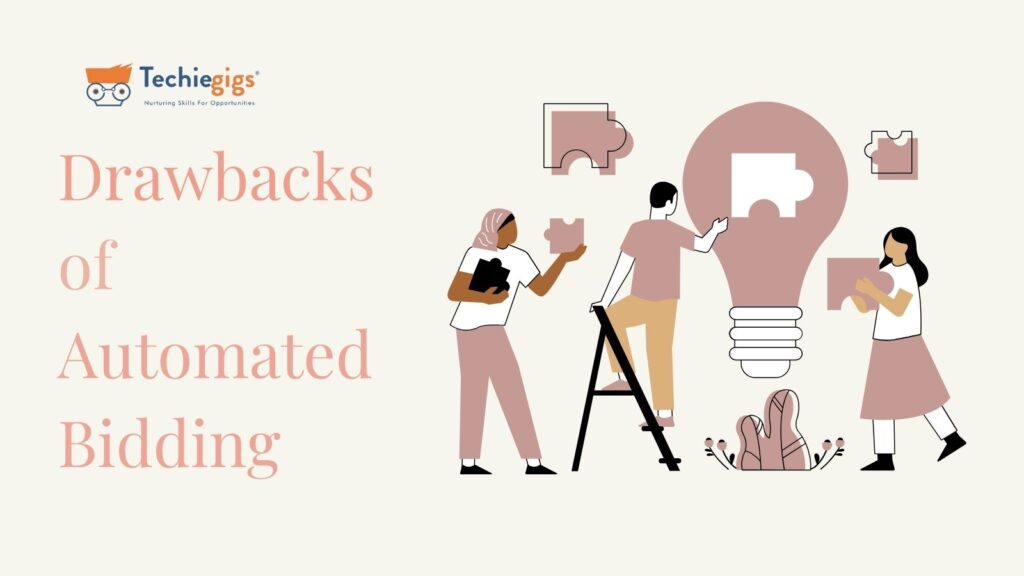
1. Loss of Control
With Automated Bidding, advertisers have limited control over individual bid adjustments, which may not always align with specific business objectives. This can be a challenge for businesses that require fine-tuned control over their ad placements and budget allocation.
2. Data Requirements
Google’s algorithms rely on sufficient historical data to optimize bids effectively. Campaigns with minimal data may struggle with bid optimization and may experience fluctuating results until enough data is gathered.
3. Budget Management
While Automated Bidding can optimize for conversions, it can sometimes lead to unexpected budget increases if not monitored properly. Advertisers must regularly review spending patterns to ensure they do not exceed their allocated budget, particularly when experimenting with different bidding strategies.
4. Learning Curve
It can take time for Automated Bidding strategies to adapt and learn effectively. During the initial learning phase, performance may fluctuate, which requires patience from advertisers before seeing optimal results.
Best Practices for Implementing Automated Bidding
1. Setting Clear Goals
To maximize the effectiveness of Automated Bidding, advertisers should define clear campaign objectives, whether it’s maximizing conversions, traffic, or brand visibility. Having measurable KPIs allows advertisers to track and adjust bidding strategies efficiently.
2. Monitoring and Adjusting Campaigns
Regular performance evaluations are crucial to ensure Automated Bidding strategies are meeting expectations. Advertisers should analyze key metrics such as conversion rates, click-through rates, and cost per conversion to fine-tune their approach. Google’s built-in reporting tools can help track performance trends and uncover opportunities for improvement.
3. Combining Strategies
Using a mix of Automated Bidding strategies can yield better results. For example, combining Target CPA with Enhanced CPC can balance automation with control. Additionally, testing different bid strategies through A/B testing can help advertisers determine which approach yields the best ROI.
4. Leveraging Audience Targeting
Pairing Automated Bidding with audience segmentation can enhance results. Advertisers should take advantage of remarketing lists, demographic data, and user behavior insights to refine bidding strategies and increase conversions.
5. Maintaining Sufficient Data for Learning
Since Automated Bidding relies heavily on advertisers, should ensure their campaigns generate enough historical data. New campaigns may need a learning period before bid strategies become fully optimized. Advertisers should avoid making frequent drastic changes, as it may reset the learning phase.
Common Misconceptions About Automated Bidding
1. “Set It and Forget It” Mentality
Many advertisers believe that once Automated Bidding is enabled, it requires no further intervention. However, continuous monitoring and optimization are necessary for sustained performance. Advertisers should frequently review bid adjustments, campaign data, and conversion trends to ensure alignment with their marketing goals.
2. Immediate Results Expectation
Algorithms need a learning period to optimize bids effectively. Advertisers should allow sufficient time for Automated Bidding strategies to adjust before making drastic changes. Expecting immediate improvements may lead to unnecessary adjustments that hinder performance. Patience and data-driven decision-making are key to maximizing the benefits of Automated Bidding.
3. One-Size-Fits-All Approach
Not all Automated Bidding strategies work for every business model. Some strategies may work better for lead generation, while others perform well for eCommerce. Advertisers should carefully evaluate their goals before selecting a bidding strategy.
Future Trends in Automated Bidding
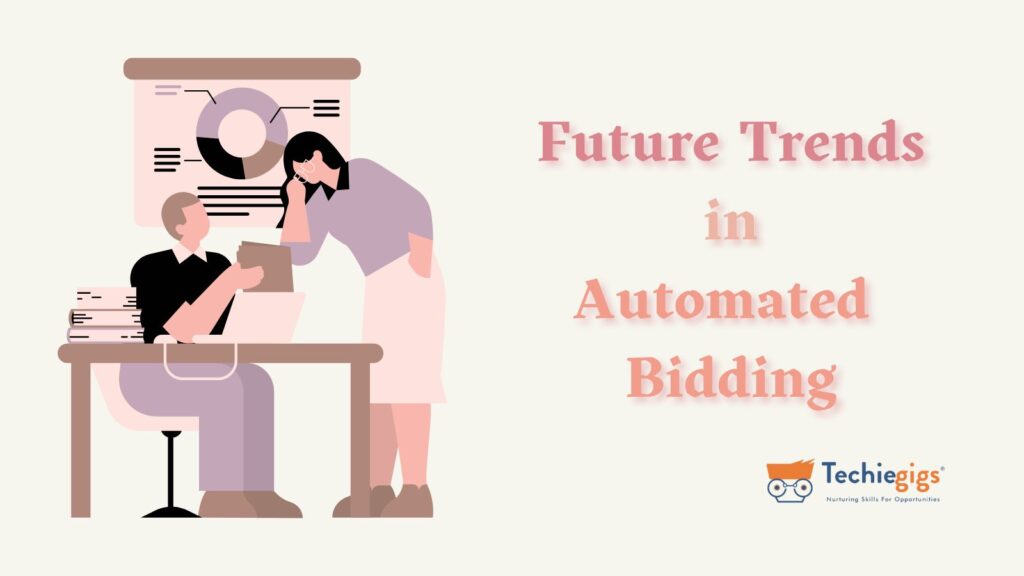
1. Advancements in AI and Machine Learning
With continuous advancements in AI, Automated Bidding will become even more precise, utilizing predictive analytics to optimize bids proactively. Google is expected to integrate more sophisticated AI capabilities, making bid optimizations faster and more accurate. These improvements will help advertisers reach their target audiences more effectively while reducing wasted ad spend.
2. Integration with Other Marketing Channels
Cross-channel Automated Bidding strategies will allow advertisers to manage bids across multiple platforms seamlessly, ensuring a holistic advertising approach. As Google enhances its integration with platforms like YouTube, Display Network, and social media ads, advertisers will be able to manage their budgets and strategies across multiple channels within a single interface. This will improve efficiency and allow for better synergy between different advertising efforts.
3. Increased Focus on User Intent and Context
Future Automated Bidding strategies will prioritize user intent more effectively, factoring in elements like search behavior, past interactions, and real-time contextual signals. By refining bidding algorithms based on behavioral trends and contextual data, Google will enable advertisers to target users at the most opportune moments, leading to higher conversion rates.
4. Smarter Budget Allocation
AI-driven budget allocation will become a key feature in future Automated Bidding strategies. Instead of static budgets, AI will distribute funds dynamically across campaigns based on real-time performance data, ensuring the highest return on investment. This will enable advertisers to maximize conversions while maintaining cost efficiency.
Conclusion
Automated Bidding is an invaluable strategy for modern advertisers looking to optimize their Google Ads campaigns. While it offers efficiency, improved performance, and real-time optimization, it also requires proper monitoring and strategic implementation. By understanding the various Automated Bidding strategies and applying best practices, advertisers can maximize their campaign success. The key to successful Automated Bidding is consistent evaluation, goal-setting, and refining strategies based on data insights. As AI technology continues to evolve, advertisers who embrace and adapt to these changes will stay ahead in the competitive digital advertising landscape.
FAQs
1. Is Automated Bidding better than manual bidding?
🔹Automated Bidding provides efficiency and real-time adjustments, making it more effective for businesses with fluctuating data. However, manual bidding allows greater control, which may be preferable for experienced advertisers with specific budget constraints.
2. How long does Automated Bidding take to optimize?
🔹Automated Bidding requires a learning period of about 7-14 days to collect sufficient data and optimize bid strategies effectively. Advertisers should avoid making drastic changes during this period.
3. Can I switch between Automated Bidding and manual bidding?
🔹Yes, advertisers can switch between bidding strategies. However, frequent changes can reset the learning period, affecting performance temporarily.
4. Does Automated Bidding guarantee better results?
🔹While Automated Bidding uses machine learning to optimize performance, success depends on factors such as campaign goals, audience targeting, and the quality of ad creatives.
5. What is the best Automated Bidding strategy for beginners?
🔹For beginners, “Maximize Clicks” or “Target CPA” is a great starting point, as they provide straightforward goal-driven automation without requiring extensive data analysis.

